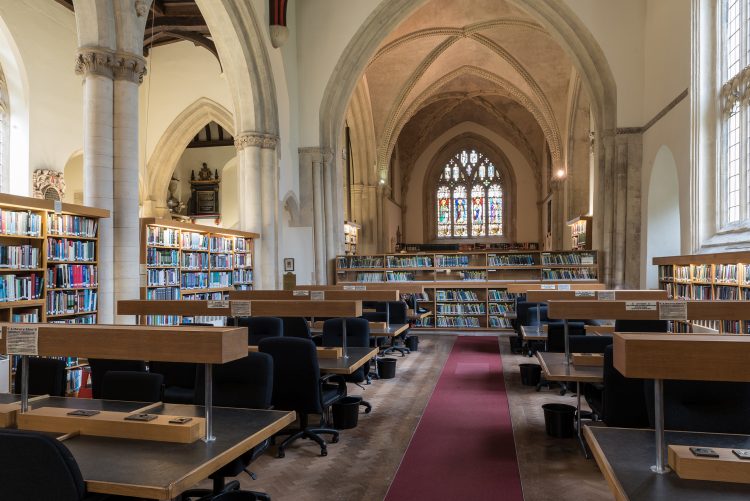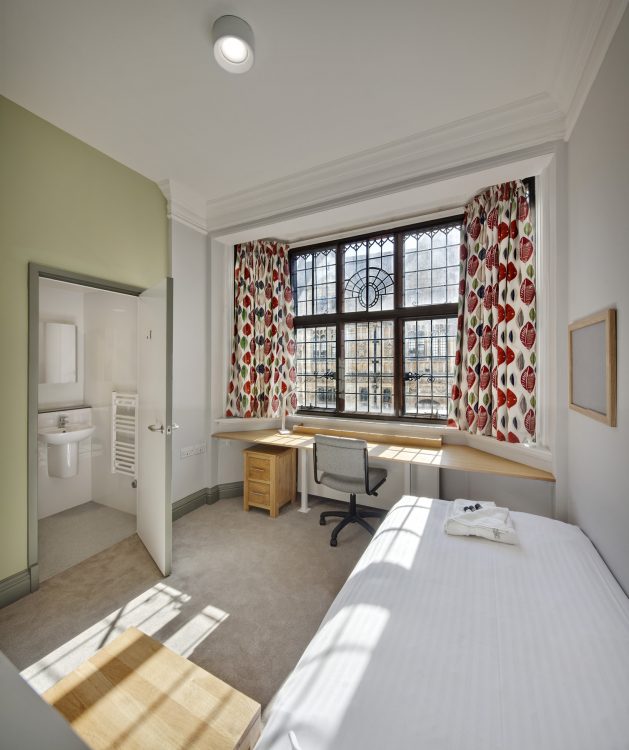Old Library
St Edmund Hall’s first collection of books was begun under the auspices of Dr Thomas Tullie (Principal 1658-1676), who initiated a system by which members going out of residence at the end of their studies would make a gift to the Hall to the value of £5, in the form of either books or plate. This custom was continued under his successors, the Rev. Stephen Penton and Dr John Mill.
Like others of its kind, the Hall had previously existed for centuries without its own library, which is unsurprising given its lack of endowment and the scarcity and expense of books, especially before the invention of the printing press. It was Penton who, in 1680, made the decision to construct a building which would house a chapel and a library together. He set about raising funds by selling the Hall’s silver plate, as well as by drawing on his own resources and encouraging donations from former students.
At first, progress was rapid. The chapel was consecrated in 1682, but the library (above the antechapel) was not completed until 1686. The building work was carried out by Oxford mason Bartholomew Peisley (who later worked on Blenheim Palace), to a design probably by William Byrd. It was reputedly the first Oxford library to have shelves against the walls, and the last to chain its books.
The Old Library’s collection is an important reflection of the history of the Hall and is comprised of approximately 4,300 books from as early as the 15th century. Works of theology are particularly prominent, but history, literature, science, geography, and even poetry are well represented. The make-up of the Old Library is a significant indicator of intellectual life in Oxford, as well as in the College, in the late 17th and 18th centuries.
Access to the Old Library
St Edmund Hall welcomes academic researchers with a legitimate reason to access the books in our Old Library collection.
Access to Old Library holdings can only be gained through a written application to the Librarian. Applications should include information about the material to which access is needed (if possible provide shelfmarks or call numbers) and reason for need. Students must supply, in advance, a letter on headed paper from their supervisor or other appropriate referee confirming access to the material is necessary for their studies.
Visiting hours are limited and all requests for appointments should be made as far in advance as possible. Please send your application to the Librarian by email or by post to Librarian, St Edmund Hall, Queen’s Lane, Oxford, OX1 4AR.
Take a virtual tour of the Old Library by clicking on the image.
Cataloguing of the Old Library
From 2013 to 2018, the older books in the Old Library were catalogued. The books, printed between 1476 and 1700, are catalogued in detail; in addition to bibliographical information for each edition, ‘copy-specific’ data are recorded for all Teddy Hall copies, including the binding, provenance, manuscript additions and signatures, bookplates, imperfections and additions.
These descriptive records have been made available to Oxford and beyond through the University’s catalogue of major collections, SOLO.
One example of a work with interesting annotations is Commendatory verses, on the author of the two Arthurs and the satyr against wit (1700), an anthology of anonymous verse attacking the Aularian poet Sir Richard Blackmore (1650–1729), which has contemporary manuscript identifications of the poets responsible – all members of a late seventeenth-century circle of Oxford ‘wits’. Dr Paul W. Nash, a specialist antiquarian book-cataloguer, has written an article discussing the annotations and the possible authorship of the book’s forty anonymous verses, which can be downloaded here.
Where next?

Library
History of the Hall
